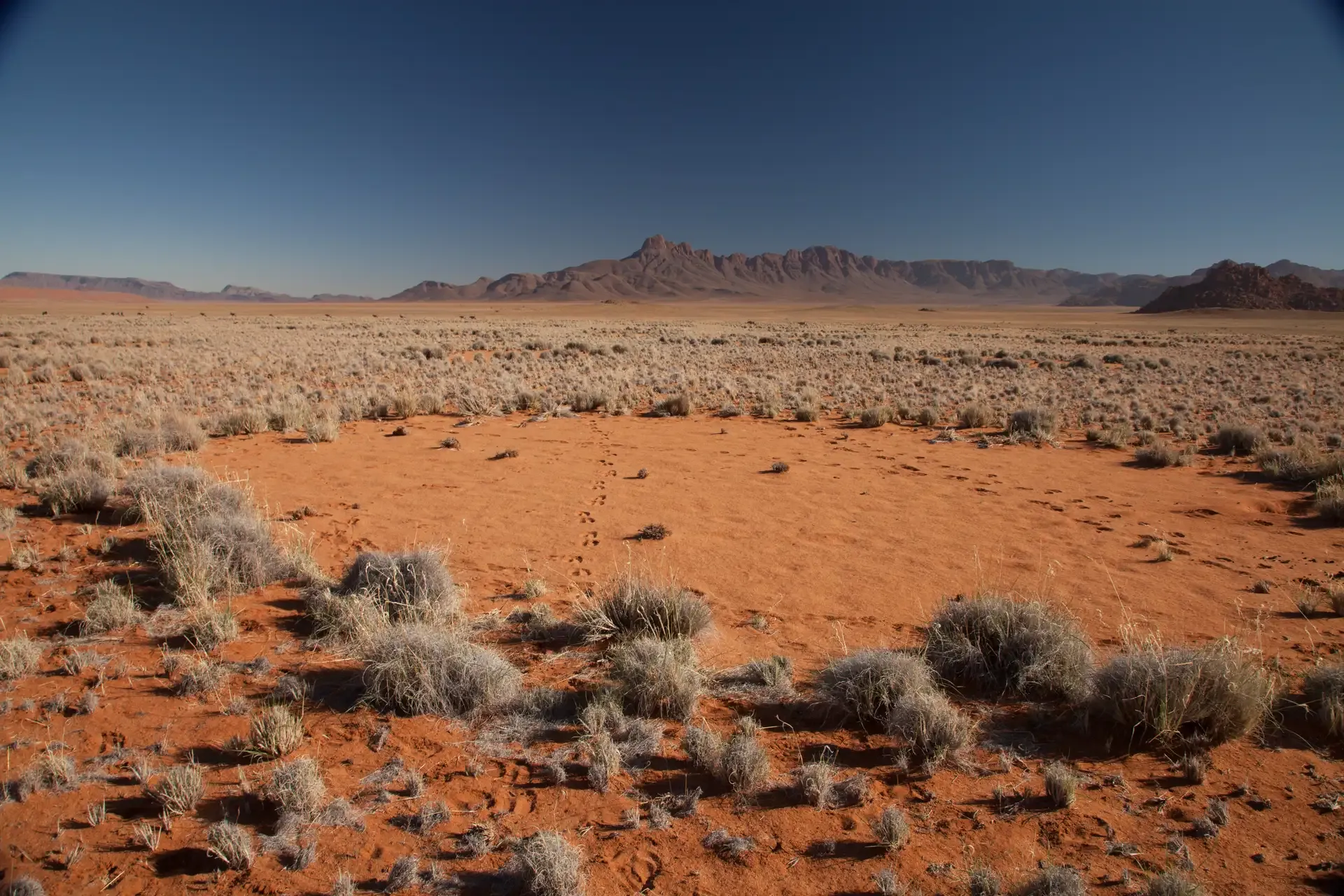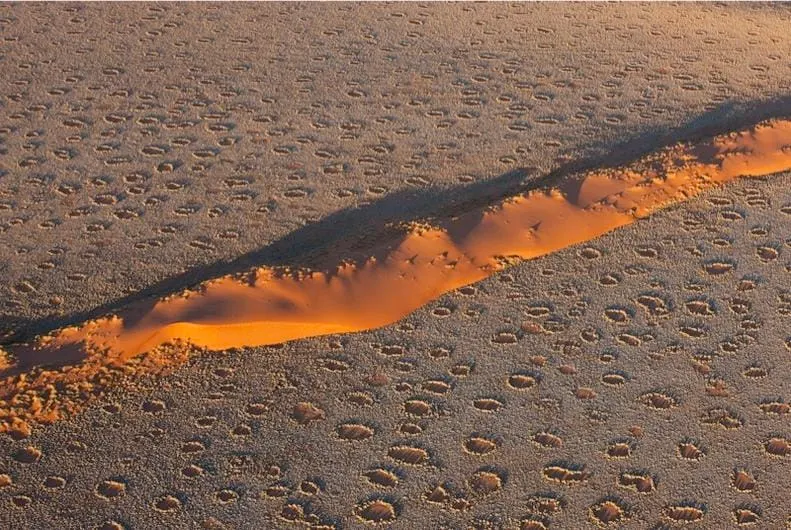Namibian mystery rings ‘Fairy Circles’/ Getty Images. Sprawling across a remote swath of the Namib Desert, rugged a grassland dotted by mill...
 |
| Namibian mystery rings ‘Fairy Circles’/ Getty Images. |
The honeycomb patterns look so uniform that the researchers ran simulations on satellite images taken from four continents.
The mystery fairy circles are located 80 to 140 kilometers (50 to 87 miles) inland from Namibia's coast, scientists are busy cracking the mystery behind Namibia’s strange fairy circles, and many studies rule out termites as a potential cause of these strange patterns. A typical fairy circle measures anywhere from 2 to 10 meters across, separated from the rest by a distance of up to 10 meters.
 |
| The 'Fairy Circles' look like honeycombs from the satellite / Discover Wildlife. |
What caused Fairy Circles?
Many theories about their formation have been created and books are written about them, but so far no one has been able to prove beyond a shadow of a doubt that their existence is the true answer to this decades-old enigma. Scientists have made steady progress on demystifying Namibia's fairy circles, with leading theories falling into two main camps of debate.
One theory contends that the circles are caused by termites feasting on glass's roots, while the other suggests that grasses self-organize to maximize water availability. But these explanations became trickier after similar circles were reported in Australia in 2016, without a clear link to termites. Recent research has pointed more firmly toward self-organization, in which the grasses form fairy circles to make the most of scant rainfall, but without necessarily ruling out termites.
Apart from sci-fi explanations, biological processes and other many theories people trying to link these mysterious circles, lately some people have speculated that UFOs or other forms of extraterrestrial origin may perhaps be involved in the desert activity more likely at night contact.
There are several plausible explanations of why fairy circles exist in a far remote part of Namibia. Some scientists are convinced it has something to do with the termites that make the Namib desert their home, research has shown that there are indeed termite colonies under most of these barren circles bordered by vegetation.
The theory goes on insinuating that termite colonies invade and conquer each other, but when similarly-sized colonies meet, they can’t annihilate each other, so they create these buffers of “no termite’s land” between them. “It’s a circular area that is bare, there’s nothing on it, and there’s this ring of grass around it,” Eugene Marais, a research manager at the Gobabeb-Namib Research Institute, describes the average fairy circle. “When you look at it from the air or from high points it almost looks like measles spots.”
Scientists have been ever trying to come up with a proven experiment to explain the reason why these barren circles exist for decades, since the 70s, we’re still having problems understanding this mysterious natural phenomenon, Marais says.
As Prof. Marais says, “we are sitting with something that should be so easy to explain, and yet finding an acceptable explanation where you can show what is causing it is proving surprisingly difficult”. Research carried out on the newer fairy circles discovered in Australia found that termites didn’t cause the barren patches, but that they were the result of abiotic processes such as mechanical weathering of the soil by heavy rain in cyclones, extreme heat, and evaporation.
“The vegetation gaps caused by harvester termites are only about half the size of the fairy circles and much less ordered,” explains Dr. Stephan Getzin from the University of Göttingen. “And in most cases, we didn’t even find any hard subterranean termitaria that elsewhere in Australia prevent the growth of grasses.”
In 2020, research led by Stephan Getzin, from the Department of Ecosystem Modeling at the University of Goettingen in Germany, added further support to the water-scarcity scenario, which Getzin and his colleagues described as an example of a Turing pattern. In their latest study, Getzin and a team of researchers returned to Namibia in hopes of finding even more compelling evidence, investigating fairy circles in 10 regions across the Namib Desert.
Getzin and his colleagues tracked sporadic rains in the 10 regions, examining the grasses, their roots and shoots, and any potential root damage wrought by termites. They studied the circumstances around dying grass after rainfall and set up soil-moisture sensors in and around fairy circles to record data at half-hour intervals, beginning in the dry season of 2020 and continuing until the end of 2022's rainy season.
Ten days after rainfall, the interior of the fairy circles had very little new growth, the study found, and what new grass had sprouted was already dying. Twenty days after rainfall, any grass inside the circles was dead, while the surrounding grass was "green and soft." Roots from dead grass inside the circles were as long – or even longer than – roots from outside the circles, suggesting the plants were investing heavily in root growth to search for water.
The researchers did not find evidence of termites feeding on the roots, they report. "The sudden absence of grass for most areas within the circles cannot be explained by the activity of termites because there was no biomass for these insects to feed on," Getzin says. "But more importantly, we can show that the termites are not responsible because the grasses die immediately after rainfall without any sign of creatures feeding on the root."
The soil sensors revealed a slow decline in soil moisture both inside and outside the circles after an initial rainfall, the researchers report, when grasses weren't well-established yet. Once the surrounding grasses were robust, however, soil moisture vanished quickly everywhere — including inside the fairy circles, despite the lack of grass there to take up the water. "Under the strong heat in the Namib, the grasses are permanently transpiring and losing water.
Hence, they create soil-moisture vacuums around their roots, and water is drawn toward them," Getzin says. "Our results strongly agree with those of researchers who have shown that water in soil diffuses quickly and horizontally in these sands even over distances greater than seven meters." This is an incredible example of "ecohydrological feedback," the researchers write, in which the barren circles essentially become reservoirs that help sustain grasses at the edges.
This research could also have implications elsewhere, Getzin points out, as this kind of self-organization seems to buffer plants against rising aridity – a problem that's already worsening in some places due to climate change. "By forming strongly patterned landscapes of evenly spaced fairy circles, the grasses act as ecosystem engineers and benefit directly from the water resource provided by the vegetation gaps," Getzin says.
"In fact, we know related self-organized vegetation structures from various other harsh drylands in the world, and in all those cases the plants have no other chance to survive except by growing exactly in such geometrical formations."








